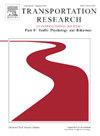小贩侵占城市道路时的不安全驾驶行为
IF 4.4
2区 工程技术
Q1 PSYCHOLOGY, APPLIED
Transportation Research Part F-Traffic Psychology and Behaviour
Pub Date : 2025-04-30
DOI:10.1016/j.trf.2025.04.022
引用次数: 0
摘要
在发展中国家,路边小贩会分散司机和摩托车手的注意力,增加撞车的风险。这项研究评估了司机和摩托车手在遇到小贩时停车或变道的意图。为了实现这一目标,我们采用了一种扩展的计划行为框架理论,将感知到的碰撞风险、过去在城市道路上与小贩接触的经验、共情关怀与计划行为理论的传统变量结合起来。对巴基斯坦拉合尔的司机和摩托车手进行了问卷调查,收集了1603份有效答复。使用偏最小二乘结构方程模型对数据进行分析,以检验提出的假设。结果表明,对与小贩接触持积极安全态度的受访者,以及曾经有过这种行为经历的受访者,更倾向于采取不安全行为,如减速/停车或超车/变道以观察和回应路边的小贩,或观察从路边小贩那里购买商品的人。研究结果强调,有必要将驾驶员关于道路干扰因素的教育与政策执行和公众意识运动结合起来,同时促进城市规划干预措施,如为街头摊贩指定区域,以加强道路安全并支持他们的生计。本文章由计算机程序翻译,如有差异,请以英文原文为准。
Unsafe driving behavior in the presence of hawkers’ encroachment on urban roads
In developing countries, roadside hawkers can distract drivers and motorcyclists, increasing the risk of crashes. This study assesses drivers’ and motorcyclists’ intentions to stop or change lanes when encountering hawkers. To achieve this, an extended theory of planned behavior framework is employed, incorporating perceived crash risk, past experiences with hawkers on urban roads, and empathic concern alongside traditional variables of the theory of planned behavior. A questionnaire survey was conducted among drivers and motorcyclists in Lahore, Pakistan, collecting 1603 valid responses. The data was analyzed using partial least squares structural equation modeling to test the proposed hypotheses. Results indicate that respondents, having positive attitudes of safety towards engaging with hawkers, and those with past experience of such behavior have higher intentions to perform unsafe behaviors, i.e., decelerate/stop or overtake/change lanes to look and respond to hawkers on the roadside, or to observe people buying goods from the roadside hawkers. The findings highlight the need for incorporating driver education on roadside distractions into licensing programs, alongside policy enforcement and public awareness campaigns, while also promoting urban planning interventions such as designated areas for street vendors to enhance road safety and support their livelihoods.
求助全文
通过发布文献求助,成功后即可免费获取论文全文。
去求助
来源期刊
CiteScore
7.60
自引率
14.60%
发文量
239
审稿时长
71 days
期刊介绍:
Transportation Research Part F: Traffic Psychology and Behaviour focuses on the behavioural and psychological aspects of traffic and transport. The aim of the journal is to enhance theory development, improve the quality of empirical studies and to stimulate the application of research findings in practice. TRF provides a focus and a means of communication for the considerable amount of research activities that are now being carried out in this field. The journal provides a forum for transportation researchers, psychologists, ergonomists, engineers and policy-makers with an interest in traffic and transport psychology.

 求助内容:
求助内容: 应助结果提醒方式:
应助结果提醒方式:


